Jèrriais
Jèrriais is the form of the Norman language spoken in Jersey, one of the Channel Islands off the coast of France. It has been in decline over the past century as English has increasingly become the language of education, commerce and administration. There are very few people who speak Jèrriais as a mother tongue and, owing to the age of the remaining speakers, their numbers decrease annually. Despite this, efforts are being made to keep the language alive.
| Jèrriais | |
|---|---|
| jèrriais | |
| Native to | Jersey and Sark |
Native speakers | 1,900 (2011 census)[1] 2,800 L2 speakers of Jersey and Guernsey |
Early forms | |
| Official status | |
Official language in | None An official language of the States of Jersey alongside the English language |
| Language codes | |
| ISO 639-3 | nrf (incl. Guernésiais) |
| Glottolog | jerr1238[2] |
| Linguasphere | 51-AAA-hc |
| IETF | nrf-JE[3][4] |
A similar language, Guernésiais, is spoken in neighbouring Guernsey. The language of Sark, Sercquiais, is a descendant of the Jèrriais brought by the Jersey colonists who settled Sark in the 16th century; and there is mutual intelligibility with the Norman language of mainland Normandy.
Jèrriais is often called "Jersey French" or "Jersey Norman French" in English (though this may give the impression that the language is a dialect of French) and "jersiais" or "normand de Jersey" in French. Jèrriais is distinct from the Jersey Legal French used for legal contracts, laws and official documents by the government and administration of Jersey. For this reason, some prefer using the term "Jersey Norman" to avoid ambiguity and to dissociate the language from standard French.
Status
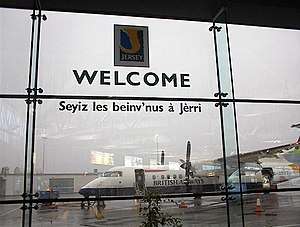
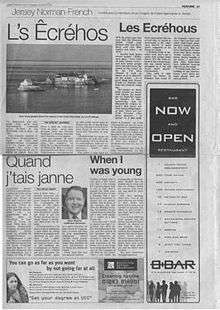
The latest figures come from the Jersey Annual Social Survey issued on 5 December 2012.[5] The survey of 4200 households took place in June 2012 and resulted in 2400 returns. It showed that 18% of the population could speak some Jèrriais words and phrases with more than 7% of those over 65 being fluent or able to speak a lot of Jèrriais. Two-thirds of adults said that they could not understand spoken Jèrriais, but more than a quarter are able to understand some, and 5% can usually or fully understand someone speaking Jèrriais. 4% of people said that they could write some Jèrriais, although under 1% could write fluently. Just under a third (32%) said that they could understand something written in Jèrriais.
These figures update those of the census (2001) which showed that approximately 3% of the island's population speak Jèrriais in their personal interactions, although research suggests that up to 15% of the population have some understanding of the language. The latest census figures also showed an increase in declarations of children speaking the language: the first such increase recorded in census figures (although this may be due to greater consciousness among parents than to language use), doubtless encouraged by the introduction of a Jèrriais teaching programme into Jersey schools.
The parish with the highest proportion (8%) of Jèrriais speakers is Saint Ouen, and that with the lowest proportion (2.1%) is Saint Helier, although Saint Helier as the largest parish has the highest number of Jèrriais speakers. The number of census respondents who stated that they "usually" spoke Jèrriais was 113; 2,761 respondents stated that they "sometimes" spoke Jèrriais. A survey[6] carried out among a sample of Jèrriais speakers in 1996 found that 18% spoke Jèrriais more often than English, 66% spoke Jèrriais as often as English, and 16% spoke Jèrriais less often than English.
The States of Jersey fund the teaching programme in schools and provide some support in terms of signage, e.g. welcome signs at harbours and airport. Ratification of the European Charter for Regional or Minority Languages is under discussion. In September 2005, the States approved the development of a cultural strategy, one of whose strategic objectives was as follows:
Jersey almost lost its language in the 20th century. By 2001 there were less than 3,000 speakers of Jèrriais. In the 21st century strenuous efforts are being made to re-establish it. Le Don Balleine, funded by the States, is leading a programme in schools teaching Jèrriais. L'Assembliée d'Jèrriais promotes the language generally. Language brings distinctiveness, a sense of localness and a whole new set of skills all of which are important qualities in attracting the creative economy. It is fundamental to the Island's identity. This objective is to work with these organisations to help in the revival and status of the language.[7]
In September 2009 a partnership agreement was signed by the Minister for Education, Sport and Culture and the President of Le Don Balleine to formalise the rôle of L'Office du Jèrriais in protecting and promoting Jèrriais and to develop a language plan to help make the language more prominent on a daily basis.
Jèrriais is currently classified as threatened by the Endangered Languages Project.[8]
There is newspaper and radio output in the language. From 2010, Jersey banknotes carry the value of the note written out in Jèrriais.[9]
Jèrriais is recognised as a regional language by the British and Irish governments within the framework of the British-Irish Council.
As of February 13, 2019, the States of Jersey adopted Jèrriais as an official language and the language is set to be used on signage and official letter headings.[10]
Literature
The literary tradition is traced back to Wace, the 12th-century Jersey-born poet, although there is little surviving literature in Jèrriais dating to before the introduction of the first printing press in Jersey in the 1780s. The first printed Jèrriais appears in the first newspapers at the end of the 18th century, and the earliest identified dated example of printed poetry is a fragment by Matchi L'Gé (Matthew Le Geyt 1777 – 1849) dated 1795.
A boom in competing newspapers and journals throughout the 19th century provided a platform for poets and writers to publish regularly – typically, satirical comment on the week's news, elections, Jersey politicians and notables.
The first printed anthology of Jèrriais poetry, Rimes Jersiaises, was published in 1865.
Influential writers include "Laelius" (Sir Robert Pipon Marett 1820 – 1884, Bailiff of Jersey 1880 – 1884), "A.A.L.G." (Augustus Aspley Le Gros 1840 – 1877), "St.-Luorenchais" (Philippe Langlois 1817 – 1884).
Elie (Edwin J. Luce 1881 – 1918) was editor of the French-language newspaper La Nouvelle Chronique de Jersey, and a poet who wrote topical poems for the newspaper. He was also active in promoting the development of drama in Jèrriais and organised performances, ultimately leading to the establishment of a Jèrriais section of the Jersey Eisteddfod in 1912.
During the Occupation, Nazi censors permitted little original writing to be published. However, many older pieces of literature were re-published in the newspapers as an act of cultural self-assertion and morale-boosting.
After the Occupation and with the re-establishment of a free press, Edward Le Brocq (1877–1964) revived a weekly column in 1946 with a letter from Ph'lip et Merrienne, supposedly a traditional old couple who would comment on the latest news or recall time past.
The most influential writer of Jèrriais in the 20th century was a U.S. citizen, George Francis Le Feuvre (1891–1984) whose pen-name was "George d'la Forge". He emigrated to North America after the First World War but for almost forty years maintained a flow of articles in Jèrriais back to Jersey for publication in newspapers. Selections of his articles have been published in book form.
Frank Le Maistre (1910–2002), compiler of the dictionary Dictionnaire Jersiais–Français, maintained a literary output starting in the 1930s with newspaper articles under the pseudonym Marie la Pie, poems, magazine articles, research into toponymy and etymology.
Since Le Maistre, Geraint Jennings has been influential in preserving the language by compiling thousands of pages of Jèrriais text online in Les Pages Jèrriaises, including parts of the Bible.
History
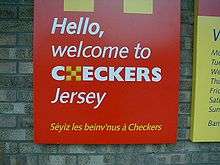
Although Jèrriais is now the first language of a very small minority, until the 19th century it was the everyday language of the majority of the population, and even until the Second World War up to half the population could communicate in the language. However, there is no complete Bible in Jèrriais (although there are versions of favourite Bible texts in Jèrriais), as French was, until the 20th century, the predominant language of the Church in Jersey (although sermons would be preached, or explained, in Jèrriais in country areas).
Awareness of the decline of language use became apparent in the 19th century in scholarly circles. Among foreign linguists, Louis Lucien Bonaparte visited Jersey and interested himself in the language and its literature. Victor Hugo, during his exile in Jersey, took an interest in the language and numbered some Jèrriais writers among his circle of acquaintances and supporters.
Sir Robert Pipon Marett's prestige and influence helped to reinforce the movement toward standardisation of the writing system based on French orthography, a trend which was also helped by the nascent Norman literary revival in the neighbouring Cotentin area of mainland Normandy where writers, inspired by the example of the Norman writers of Jersey and Guernsey, began their own production of literary works. However, differing (if mutually comprehensible) writing systems have been adopted in Jersey, Guernsey and mainland Normandy. The question is sometimes raised as to whether Jèrriais should move to a writing system based on English orthography, however this would have implications for the continuity of the literary tradition over two centuries or more (note though, that the digraph "th" for the typical dental fricative of Jèrriais has evidently been borrowed from English orthography).
As English became dominant in Jersey in the 20th century, efforts were made to preserve the Jèrriais language. The Jersey Eisteddfod has included a Jèrriais section since 1912. Associations were founded. L'Assembliée d'Jèrriais was founded in 1951, while Le Don Balleine is a trust set up in accordance with the will of Arthur E. Balleine (1864–1943), who bequeathed funds for the promotion of the language. L'Assembliée d'Jèrriais launched a quarterly magazine in 1952, which has been published since (with the occasional hiatus, and latterly under the editorship of Le Don Balleine); a standard grammar Lé Jèrriais pour tous (by Paul Birt) appeared in 1985; cassettes, booklets and other materials have also been produced.
George d'la Forge's maintenance of the language in the North American diaspora is not as surprising as it might seem, as considerable numbers of Jersey people had been involved in the economic development and exploitation of the New World (see New Jersey). Much of the concentration focused on the cod fisheries of the Gaspé peninsula in Quebec, Canada, which were controlled into the early 20th century by Jersey-based companies or companies of Jersey origin employing Jersey labour. The common language of business was Jèrriais, and it is reported that there were still some Jèrriais-speakers in Gaspé villages in the 1960s. The Gaspesian expression "faire une runne" (to go and work outside the region) comes from the Jèrriais word "run" applied to a fishing station.[11]

The use of Jèrriais is also to be noted during the German Occupation of the Channel Islands during the Second World War; the local population used Jèrriais among themselves as a language neither the occupying Germans, nor their French interpreters, could understand. However, the social and economic upheaval of the War meant that use of English increased dramatically after the Liberation.
It is considered that the last monolingual adult speakers probably died in the 1950s , although monolingual speaking children were being received into schools in St. Ouen as late as the late 1970s.
Famous Jèrriais speakers include Lillie Langtry and Sir John Everett Millais, the Pre-Raphaelite painter.
Dictionaries
The history of Jèrriais dictionaries goes back to 19th-century manuscript glossaries work of Philippe Langlois, A. A. Le Gros and Thomas Gaudin. These were later revised and expanded into the Glossaire du Patois Jersiais published in 1924 by La Société Jersiaise. The 1960 Glossary of Jersey French (Nichol Spence) recorded Jèrriais in phonetic script. The 1924 Glossaire inspired the research by Frank Le Maistre that culminated in the Dictionnaire Jersiais–Français published in 1966 to mark the 900th anniversary of the Norman Conquest of England. The first practical English–Jèrriais dictionary was the English-Jersey Language Vocabulary (Albert Carré in collaboration with Frank Le Maistre and Philip de Veulle, 1972) which was itself based on the Dictionnaire Jersiais–Français. A children's picture dictionary Les Preunmié Mille Mots was published by La Société Jersiaise in 2000. In 2005 a Jèrriais–English dictionary Dictionnaithe Jèrriais-Angliais was published by La Société Jersiaise, in collaboration with Le Don Balleine. A revised, modernised and expanded English–Jèrriais dictionary Dictionnaithe Angliais-Jèrriais, was published in 2008 by Le Don Balleine.[12]
Vocabulary
Although Jèrriais is occasionally misleadingly described as a mixture of Norse and French, it would be more linguistically accurate to state that when the Norse-speaking Normans (lit. North-man) conquered the territory that is now called Normandy they started speaking the langue d'oïl of their new subjects. The Norman language is therefore basically a Romance language with a certain amount of vocabulary of Norse origin, plus later loanwords from other languages. [13]
Influence of Norse
Norse origins can be seen in Jèrriais words such as these:
Influence of Breton
Jèrriais has also adopted a small number of words from the Breton language (e.g. pihangne 'spider crab', from Breton bihan 'small'; quédaine 'fast', from Breton gaden 'hare'), although the influence on today's language has overwhelmingly been from French and, increasingly, English.
Influence of French
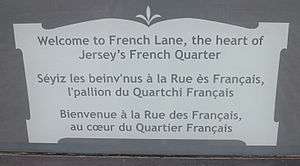
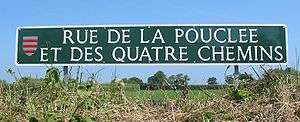
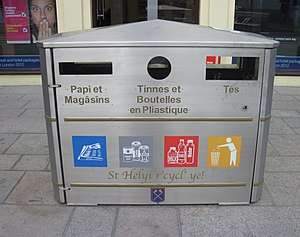
A large number of gallicisms have been introduced into the language due to the use of French as an official language and the cultural influence of France and French literature. Some French words have displaced in modern usage Jèrriais words that can still be found in older texts from the 18th and 19th centuries, for example:
- French leçon (in the form léçon) has displaced native lichon (lesson)
- French garçon has displaced native hardé (boy)
- French chanson has displaced native canchon (song)
Efforts are being made to maintain some Jèrriais words which are competing in usage with French forms, for example:
- native hielle is being promoted over French huile (oil)
- native huiptante (eighty) is being promoted over French quatre-vingts (fourscore)
Influence of English
Some maritime vocabulary was borrowed from English at an early date, for example baûsouîn (boatswain), but by the late 18th century some domestic vocabulary, such as:
- bliatchinner (to polish shoes, from blacking)
- coutchi (to cook)
- grévîn (gravy)
- ouâchinner (to rub in soapy water, from washing)
- scrobbine-broche (scrubbing brush)
- sâsse-paine (saucepan)
- stchilet (skillet)
- ticl'ye (from tea-kettle)
- code à phôner (phone code)
entered the language through the employment of Jèrriais-speaking servants in the houses of bourgeois English-speaking immigrants.
Other words borrowed from English before 1900 include:
- chârer (to share)
- drâses (underpants, from drawers)
- ouothinner (to worry)
- ouadinne (cotton wool, from wadding)
- nosse (nurse)
- souîndgi (to throw, from swing)
- sténer (to stand, to endure)
However, care needs to be taken in attempting to identify anglicisms because some words, such as mogue (mug) and canne (can), which are often assumed to have been borrowed from English, were in fact Norman words exported to England in the wake of the Norman Conquest; and words such as fliotchet (flock) and ridgi (rig) are Norman cognates of English words.
More recently, words such as boutchi (to book), partchi (to park) and tyeur (tyre) have been absorbed into the language, although current initiatives in creating neologisms for technological and social innovations prefer to avoid wholesale borrowing where possible. Among recent coinings are words such as textéthie for texting, maître-pêtre for webmaster (literally master-spider) and mégabouochie for megabyte.
Phonology
The phonological influence of Norse is debated, although the aspirated "h" may be due to Norse influence.
Palatalisation
The palatalisation of Latin /k/ and /ɡ/ before /a/ that occurred in the development of French did not occur in northern dialects of Norman, including Jèrriais:
| Jèrriais | English | French |
| acater | to buy | acheter |
| cat | cat | chat |
| cow | vache | |
| caud | warm | chaud |
| gardîn | garden | jardin |
| gambe | leg | jambe |

However the palatalisation of /k/ before front vowel produced different results in the Norman dialect that developed into Jèrriais than in French. (Many developments are similar to those in Italian, cf. cento-hundred and faccia-face).
| Jèrriais | English | French |
| bachîn | basin | bassine |
| face | face | |
| faichon | fashion | façon |
| chent | hundred | cent |

At a later date surviving /k/ and /ɡ/ underwent a secondary process of palatalisation:
| Jèrriais | English | French |
| motchi | to mock | moquer |
| patchet | packet | paquet |
| dgide | guide | guide |
| idgiot | idiot | idiot |
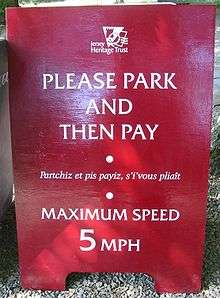
This palatalisation continues to operate (except in initial position) as can be seen by recent borrowings from English:
| Jèrriais | English |
| beustchi | to busk |
| coutchi | to cook |
| pliodgi | to plug |
| braidgeux | bragger |
Dental fricative
A feature of Jèrriais that is immediately noticeable and distinguishes it from neighbouring languages is the voiced dental fricative /ð/, written th, that typically occurs in intervocalic position:
| Jèrriais | French | English |
| bathi | barril | barrel |
| m'suther | mesurer | to measure |
| paiethie | paierie (payment office) | payment |
| ouothilyi | oreiller | pillow |

Or in final position:
| Jèrriais | French | English |
| méthe | mère | mother |
| braithe | braire (bray) | to cry |
The fricative devoices to assimilate with a neighbouring unvoiced consonant in words such as paqu'thie (packing) or malaûc'theux (disgusting).
The fricative developed from /r/ + front vowel, but evidently after the 16th century as this feature is unknown in the language of Sark (colonised by Jersey families). Although the voiced dental fricative is standard in the literary language, it is not found in the eastern dialects.
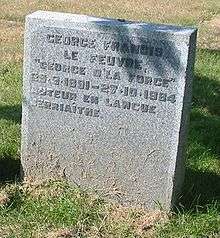
Some older speakers in St. Ouen use a dental fricative in positions where other dialects show a /z/. This may be represented in the orthography of particular writers.
| standard Jèrriais | St. Ouennais | English |
| maîson | maiethon | house |
| ouaîselîn | ouaiethelîn | birds (collective) |
| tchaîse | tchaîthe | chair |
| anglyiciser | anglyicîther | anglicise |
The dental fricative in the dialect of such speakers may also be heard in liaison:
| standard Jèrriais | St. Ouennais | English |
| ous êtes | ous'th êtes | you are |
| ches ôtis | ches'th ôtis | these tools |
| nou-s-a | nou-th-a | one has |
Length
Length is phonemic in Jèrriais. Long vowels are usually indicated in writing by a circumflex accent. A noun ending in a vowel lengthens the final vowel to indicate the plural (shown in writing by adding an s).
Gemination occurs regularly in verb tenses, indicated by a consonant-apostrophe-consonant trigraph, for example: ou pâl'la (she will speak); jé c'mench'chons (we will begin); i' donn'nait (he would give). Gerunds will also regularly contain geminate consonants, for example: faîs'sie (doing, making); chant'tie (singing); tith'thie (shooting); brîng'gie (sweeping); gângn'nie (winning).
Grammar
Verbs
Aspect
Jèrriais distinguishes between simple, progressive and perfect aspect:
Past:
| preterite | j'pâlînmes | we spoke |
| progressive | ou 'tait à pâler | she was speaking |
| perfect | ous avez pâlé | you have spoken |
| imperfect | j'pâlais | I spoke |
Future:
| simple | j'pâl'lai | I will speak |
| progressive | tu s'sa à pâler | you will be speaking |
| perfect | oulle étha pâlé | she will have spoken |
Present:
| simple | j'pâle | I speak |
| progressive | i' sont à pâler | they are speaking |
Iterative
Verbs can be made iterative in aspect by prefixing èr- (long form) or r' (short form):
| aver | have |
| èraver | have again |
| êt' | be |
| èrêt' | be again |
| netti | clean |
| èrnettit | clean again |
| muchi | hide |
| èrmuchi | hide again |
| èrgarder | watch |
| èrèrgarder | watch again |
| téléphoner | phone |
| èrtéléphoner | phone again |
Gerunds
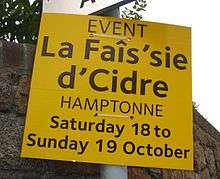
Verbs can be transformed into gerunds, which are commonly used:
| chanter | sing |
| chant'tie | singing |
| faithe | make |
| faîs'sie | making |
| haler | pull |
| hal'lie | hauling, haulage |
| partchi | park |
| parqu'thie | parking |
| liéthe | read |
| liéthie | reading |
| faxer | fax |
| faxéthie | faxing |
Examples

| Jèrriais | French | English |
| Jèrri | Jersey | Jersey |
| beinv'nu | bienvenue | welcome |
| bel | cour | yard |
| bieauté | beauté | beauty |
| bouônjour | bonjour | hello |
| pantalon | trousers | |
| brînge | brosse | brush |
| chièr | cher | dear |
| compather | comparer | compare |
| l'êtrangi | l'étranger | abroad |
| janmais | jamais | never |
| lian | lien | link |
| sac | bag | |
| tchaîse | chaise | chair |
| chien | dog | |
| ticl'ye | bouilloire | kettle |
| viages | voyages | journeys |
| yi | oeil | eye |
See also
| Norman language (including Jèrriais) edition of Wikipedia, the free encyclopedia |
References
- Jèrriais at Ethnologue (18th ed., 2015)
- Hammarström, Harald; Forkel, Robert; Haspelmath, Martin, eds. (2017). "Jerriais". Glottolog 3.0. Jena, Germany: Max Planck Institute for the Science of Human History.
- "Jèrriais/Guernésiais". IANA language subtag registry. Retrieved 11 February 2019.
- "Jersey". IANA language subtag registry. Retrieved 11 February 2019.
- "Jersey Annual Social Survey 2012" (PDF). 2012.
- Jèrriais: Jersey's Native Tongue, Jones 2003
- "Archived copy". Archived from the original on May 11, 2011. Retrieved May 31, 2011.CS1 maint: archived copy as title (link)
- "Endangered Languages Project - Jèrriais". Retrieved 2019-09-10.
- Jersey, States of. "Jersey's bank notes". www.gov.je.
- "States agree to promote Jèrriais".
- Fallu, Jean-Marie. "La Gaspésie jersiaise" (PDF). Magazine Gaspésie, Été 2012, no 174. Musée de la Gaspésie. Archived from the original (PDF) on 29 July 2013. Retrieved 22 July 2012.
- Dictionnaithe Angliais-Jèrriais, Jersey 2008, ISBN 1-904210-09-0
- "Jèrriais words of Norse origin". members.societe-jersiaise.org.
Literature
- Lé Jèrriais Pour Tous by Paul W. Birt, 1985.
- Dictionnaire Jersiais–Français, 1966.
- A Grammar of the Norman French of the Channel Islands: The Dialects of Jersey and Sark by Anthony J. Liddicoat, 1994. ISBN 978-3-11-087728-1
- Jersey Norman French: A Linguistic Study of An Obsolescent Dialect . Mari C. Jones, 2001
- Jèrriais: Jersey's Native Tongue by Mari C. Jones, 2003. ISBN 978-1-904210-03-0
- Dictionnaithe Jèrriais-Angliais. 2005. ISBN 0-901897-40-X
- Les Chroniques du Don Balleine/Les Nouvelles Chroniques du Don Balleine (magazine). Jersey 1979 – current.
External links
| Wikimedia Commons has media related to Jèrriais. |
- L'Office du Jèrriais
- La Société Jersiaise – La Section de la langue Jèrriaise
- La Société Jersiaise – Les Pages Jèrriaises
- BBC Radio Jersey – Jèrriais
- The Lord's prayer in Jèrriais
- Jèrriais and Sercquiais today by Dr Mari C. Jones – from the BBC